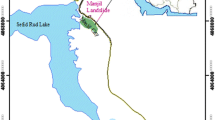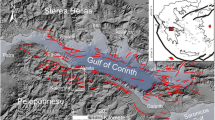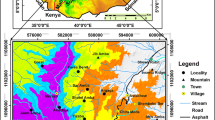Abstract
This paper presents results of recent studies on distribution and category of landslides in one section of the Sichuan–Tibet Highway, adjacent to the northern side of the Yarlu Tsangpo Grand Canyon, Tibet, Southwestern China. In the tectonic setting predominated by compression and strike-slipping, active faults are dominant and result in the genesis of the great alpine relief together with fluvial incision and unloading. In this section, with a distance of about 290 km between Ranwu and Lulang, 34 landslides occurred. Among them, the 12 large and super-large landslides comprise the most dangerous part of the highway system to road users over the past 50 years. The landslides usually occurred in slopes comprised of moraine with a large thickness, fluvio-pluvial and lacustrine deposits and fractured rocks. Based on the examination of the physical geography, structural geology, Quaternary geology, stratigraphy and petrography, this paper presents the temporal-spatial distribution of landslides along the section and classification of them into three types with respect to mechanism and composites of landslides.
-
Type 1.
Landslide initiated at high elevation and transformed into a distal debris flow damming the river with a long reoccurrence interval
-
Type 2.
Landslide at stream banks, in different ranks of mass movements in dissecting layers of moraines
-
Type 3.
Landslide of fractured rock mass with quick translation movements.
Each of the three types is presented by distinctive case examples. Type 1 is Yigong Landslide; type 2 includes Dongjiu Landslide group, 102 Landslide group, Suotong Landslide group, Songzong Landslide; and the type 3 is Layue Landslide. A binary landslide, which is seldom seen in nature and which occurred in the outlet of one creek under the integrative function of fluvial incision and road cut, is also presented. These are distributed in different parts of the area with characterized structural geology, topography and composites (gneiss and Quaternary deposits) with accumulative quantity between Suotong and Dongjiu. The most occurred with frequent and rapid translation, shallow shearing planes, various influential factors and unique triggering factors, and a variable period of reoccurrence with a tendency of increasing magnitude. In this region, six influential factors greatly contribute to their occurrence: (a) intensive neotectonic movements, (b) ongoing alpine canyon relief, (c) earthquakes, (d) heavy precipitation, (e) stream erosion, and (f) human activities, to a certain extent. Mostly, the latter four factors play major roles in triggering landslide occurrence. The earthquake causes the rock and soil to fracture and deform, and tends to be unstable, or cause earth-induced landslides. The heavy rainfall in monsoon seasons which saturates the soil and lower the shearing strength is mostly responsible for the occurrence of landslides. The stream erosion disturbs slope toes causing progressive failure. Road construction and deforestation decrease the natural slope stability. Comments and suggestions on the physical measures for remediation of landslides and safety of highways are also made.














Similar content being viewed by others
References
Arrowsmith JR, Pollard DD, Rhodes DD (1996) Hill slope development in areas of active tectonics. Journal of Geophysical Research 101(B3):6255–6275
Barnard PL, Owen LA, Sharma MC, Finkel RC (2001) Natural and human-induced landsliding in the Garhwal Himalaya of Northern India. Geomorphology 40:21–35
BGMRXAR (1993) Regional Geology of Xizang (Tibet) Autonomous Region. Bureau of Geology and Mineral Resources of Xizang Autonomous Region (BGMRXAR), Geological Publishing House (in Chinese with brief text in English)
BGMRXAR (1994) Field Investigation Report of Regional Geology (Basu and Songzong Regions). Bureau of Geology and Mineral Resources of Xizang Autonomous Region (BGMRXAR) (in Chinese)
BGMRXAR (1995) Field Investigation Report of the Regional Geology (Tongmai and Bomi). Bureau of Geology and Mineral Resources of Xizang Autonomous Region (BGMRXAR), Bureau of Geology Press, Lasha (in Chinese)
Bhasin R, Grimstad E, Larsen JO (2002) Landslide hazards and mitigation measures at Gangtok, Sikkim Himalaya. Engineering Geology 64:351–368
Brookfield ME (1998) The evolution of the great river systems of southern Asia during the Cenozoic India-Asia collision: rivers draining southwards. Geomorphology 22:285–312
Cai HJ, Liu HC, Zhang ZY (1995) The catalog of Chinese landslide dam events. J Geol Hazard Environ Pres 6(4):1–9 (in Chinese with English abstract)
Choubey VD, Litoria PK (1990) Landslide hazard zonation in the Garhwal Himalaya: a terrain evaluation approach. Proceedings of the 6th International IAEG Congress, Balkema, Rotterdam, pp 65–72
Coleman M, Hodges K (1995) Evidence for Tibetan plateau uplift before 14 Myr ago from a new minimum age for east-west extension. Nature 374:49–52
Costa JE (1984) Physical geomorphology of debris flows. In: Costa JE, Fleisher PJ (eds) Developments and applications of geomorphology. Springer-Verlag Berlin Heidelberg, pp 268–317
Costa JE, Schuster RL (1988) The formation and failure of natural dams. Geol Soc Amer Bull 100:1054–1068
Crozier MJ (1986) Landslides: causes, consequences and environment. Croom Helm, London, p 252
Cruden DM, Varnes DJ (1996) Landslide types and processes. In: Turner AK, Schuster RL (eds) Special Report 247: Landslides: Investigation and Mitigation. TRB, National Research Council. National Academy Press, Washington DC, pp 36–75
Ding L, Zhong DL (1999) Metamorphic characteristics and geotectonic implications of the high-pressure granulites from Namjagbarwa, eastern Tibet (in Chinese). Sci China D 29:385–397 (in Chinese)
Du RL, Wang Q, Zhang PZ (2001) Present-day crustal movement and tectonic deformation in continental China GPS surveys and velocity field. In: Ma ZJ, Wang YP, Zhang YP (eds) Study on the recent deformation and dynamics of the lithosphere of Qinghai-Xizang Plateau. Seismological Press, Beijing, pp 1–20 (in Chinese with English abstract)
Feng S, Yao TD, Jiang H (2001) Temperature variations over Qinghai-Xizang plateau in the past 600 years. Plateau Meteorol 20:105–108 (in Chinese)
Fielding EJ (1996) Tibet uplift and erosion. Tectonophysics 260:55–84
Fort M (2000) Glaciers and mass wasting processes: their influence on the shaping of the Kali Gandaki valley (higher Himalaya of Nepal). Quatern Int 65/66:101–119
Hewitt K (1999) Quaternary moraines vs catastrophic rock avalanches in the Karakoram Himalaya, Northern Pakistan. Quatern Res 51:220–237
Hodges KV (2000) Tectonics of the Himalaya and southern Tibet from two perspectives. Geol Soc Amer Bull 112: 324–350
Ibetsberger HJ (1996) The tsergo Ri landslide: an uncommon area of high morphological activity in the Langthang valley, Nepal. Tectonophysics 260:85–93
IMHE and ITS (1999) Study of typical mountain hazards along Sichuan-Tibet Highway. IMHE (Institute of Mountain Hazards and Environment, the Chinese Academy of Sciences and Water Conservancy Ministry of China) and ITS (Institute of the Traffic Science, the Traffic Department of the Tibet Autonomous Region. Chengdu Science and Technology University Publishing House (in Chinese with English preface)
IMHE, CAREERI and ITS (1995) Mountain Hazards in South Branch of Sichuan-Tibet Highway (within Tibet) and Remediation Measures. IMEHE (Institute of Mountain Hazards and Environment, the Chinese Academy of Sciences and Water Conservancy Ministry of China), CAREERI (Cold and Arid Regions Environmental and Engineering Research Institute, Chinese Academy of Sciences), and ITS (Institute of the Traffic Science, the Traffic Department of the Tibet Autonomous Region). Beijing Science Press (in Chinese)
Keefer DK (1994) The importance of earthquake-induced landslides to long-term slope erosion and slope-failure hazards in seismically active regions. Geomorphology 10:265–284
Keller EA, Pinter N (1996) Active tectonics: earthquakes, uplifts, and landscape. Prentice Hall Upper Saddle River, New Jersey, pp 295–298
Kojan E, Hutchinson JN (1978) Mayunmarca rockslide and debris flow, Peru. In: Voight B (eds) Rockslides and avalanches, 1. Natural phenomena. Elsevier, Amsterdam, pp 315–361
Li TD (1996) The process and mechanism of the rise of the Qinghai-Tibet Plateau. Tectonophysics 260:45–53
Liu W (2002) Study on the characteristics of huge scale-super high speed-long distance landslide chain in Yigong, Tibet. Chin J Geol Hazard Control 13(3):9–18 (in Chinese with English abstract)
Liu GR, Yan EC, Lian C (2002) Discussion on classification of landslides. J Eng Geol 10(4):339–342 (in Chinese with English abstract)
Ma ZJ, Zhang JS, Wang YP (2001) Changes of the 3-d movement sense along with time in the Qinghai-Xizang Plateau. In: Ma ZJ, Wang YP, Zhang YP (eds) Study on the recent deformation and dynamics of the lithosphere of Qinghai-Xizang Plateau. Seismological Press, Beijing, pp 88–105 (in Chinese with English abstract)
Molnar P (1986) The geological history and structure of the Himalaya. Am Sci 74:144–154
Pachauri AK, Gupta PV, Chander R (1998) Landslide zoning in a part of the Garhwal Himalayas. Environ Geol 36:325–334
Pan YS (1999) Formation and uplift of the Tibet Plateau (in Chinese with English abstract). Geosci Front 6(3):153–163
Pan YS, Kong XR (1998) Lithosphere structure evolvement and dynamics of Tibet Plateau. Guangdong Science and Technology Press, Guangzhou, pp 335–364 (in Chinese)
Parise M, Sorriso-Valvo M, Tansi C (1997) Mass movements related to tectonics in the Aspromonte massif (Southern Italy). Eng Geol 47:89–106
Penck W (1953) Morphological analysis of land forms. MacMillan, New York, p 429
Philip H, Ritz JF (1999) Gigantic paleolandslide associated with active faulting along the Bogd fault (Gobi-Altay, Mongolia). Geology 27:211–214
Rautela P, Lakhera RC (2000) Landslide risk analysis between Giri and Tons Rivers in Himachal Himalaya. JAG 2(3–4):153–160
Ren JW, Shen J, Cao ZQ, Wang YP (2000) New cognition of Jiali Fault in the southeast of Tibet (in Chinese with English abstract). Earth Geol 22(4):344–350
Ruddiman W (1998) Early uplift in Tibet? Nature 394:723–725
Schenk PM, Bulmer MH (1998) Origin of mountains on lo by thrust faulting and large-scale mass movement. Science 279:1514–1517
Schramm JM, Weidinger JT, Ibetsberger HJ (1998) Petrologic and structural controls on geomorphology of prehistoric Tsergo Ri slope failure, Langtang Himal, Nepal. Geomorphology 26:107–121
Shang YJ, Yang ZF, Li LH, Liu DA,Wang YC (2003a) A super-large landslide in Tibet in 2000: background, occurrence, disaster, and origin. Geomorphology 54(3–4):225–243
Shang YJ, Yue ZQ, Yang ZF, Zhu PY, Wang YC (2003b) Addressing severe slope failure hazards along Sichuan-Tibet Highway in Southwestern China. Episodes 26(2):94–104
Shang YJ, Park HD, Yang ZF, Zhang LQ (2004) Debris formation due to weathering, avalanching and rock falling, landsliding in SE Tibet. Int J Rock Mech Mining Sci 41(3):528–529
SHS (Sichuan General Hydraulic Gauging Station) (1979) Handbook hydrology in Sichuan (in Chinese)
Strecker MR, Marrett R (1999) Kinematic evolution of fault ramps and its role in development of landslides and lakes in the northwestern Argentine Andes. Geology 27:307–310
Sun HL (1996) Formation and evolution of Tibetan Plateau. Shanghai Science and Technology Press, pp 180–181
TPSRT (The Tibet Plateau Synthesis Scientific Research Team of Chinese Academy of Sciences) (1982) Natural Geography of Tibet. Science Press, Beijing, pp 14–118 (in Chinese)
TPSRT (The Tibet Plateau Synthesis Scientific Research Team of Chinese Academy of Sciences) (1984) Rivers and lakes of Tibet. Science Press, Beijing (in Chinese)
TPSRT (The Tibet Plateau Synthesis Scientific Research Team of Chinese Academy of Sciences) (1986) Glaciers of Tibet. Science Press, Beijing (in Chinese)
Varnes DJ (1978) Slope movement types and processes. In: Schuster RL, Krizek RJ (eds) Landslides: analysis and control (Special Report 176). TRB National Research Council, Washington DC, pp 11–33
Wang CH, Zhang XG (1998) Analysis on formation and developing process of the 102 landslide group on the Sichuan-Tibet Highway. In: Cui P (eds) Proceedings of Research on Mountain Disasters and Environmental Protection across Taiwan Straint. Sichuan Science and Technology Press, Chengdu, vol 1, pp 251–255 (in Chinese with English abstract)
Xu ZQ, Yang JS, Jiang M, Li HB (1999) Continental subduction and uplifting of the orogenic belts at the margin of the Qinghai-Tibet Plateau (in Chinese with English abstract). Earth Sci Front (China University of Geosciences, Beijing) 6(3):139–151
Yang QZ (2002) Landslide and its prevention and control in Tibet. Chin J Geol Hazard Control 13(1):94–97 (in Chinese with English abstract)
Yin YP (2000) A study of characteristics of Yigong rapid huge landslide and hazards protection. Chin J Hydrogeol Eng Geol (4):8–11
Yin KL (2003) Classification of landslide hazard prediction and warning. Chin J Geol Hazard Control 14(4):12–18 (in Chinese with English abstract)
Ying SF, Huang LR, Guo LQ, Zhu WY (1999) Horizontal deformation of Chinese continent obtained by GPS survey (in Chinese with English abstract). Seismol Geol 21:459–464
Zeng JL (2000) Summaries of resources in Tibet. Tibet Sci Technol 4:29–33
Zhong DL, Ding L (1996) Process of the uplift of the Tibet Plateau and its mechanism research. Chin Sci D 26(4):289–295
Zhong DL, Wu GY, Ding L (1998) Characteristics of Cenozoic intracontinental deformation of Eastern Tibet. In: Pan YS, Kong XR (eds) Lithosphere structure, evolution and dynamics of Qinghai-Xiang (Tibetan) Plateau. Guangdong Science & Technology Press, Guangdong, pp 335–364 (in Chinese)
Zhou CH, Yue ZQ, Lee CF, Zhu BQ, Wang ZH (2001) Satellite image analysis of a huge landslide at Yi Gong, Tibet, China. Q J Eng Geol Hydrogeol 34(4):325–332
Zhu PY, Wang CH, Tang BX (2000) The deposition characteristic of supper flow in Tibet (in Chinese with English abstract). J Mount Sci 18(5):453–456
Acknowledgements
The field investigation was assisted by Profs. C.H. Wang and P.Y. Zhu and was supported by Prof. P. Cui from the Institute of Mountain Hazards and Environment, Chinese Academy of Sciences & Ministry of Water Conservancy of China. The authors acknowledge the Special Funds for Major State Basic Research Project of China under Grant No. 2002CB412701. The authors also appreciate the support from the Brain Korea 21 Project in 2004 and from the Research Institute of Engineering Science, Seoul National University.
Author information
Authors and Affiliations
Rights and permissions
About this article
Cite this article
Shang, Y., Park, HD., Yang, Z. et al. Distribution of landslides adjacent to the northern side of the Yarlu Tsangpo Grand Canyon in Tibet, China. Environ Geol 48, 721–741 (2005). https://doi.org/10.1007/s00254-005-0012-4
Received:
Accepted:
Published:
Issue Date:
DOI: https://doi.org/10.1007/s00254-005-0012-4




